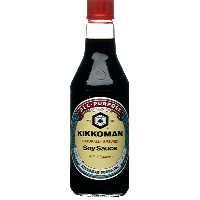Soy sauce
A universal condiment, soy sauce can be applied indiscriminately to any food to dramatically improve it's taste. Condiment use is critical in the practice of safe eating. Most varieties of soy sauce are salty, "earthy", brownish liquids intended to season food. Although, admittedly, these can also refer to diarrhea; it is in fact a perfectly fine substitute.
Production[edit]
Soy sauce is produced in a central distillation and bottling facility located somewhere in Tibet. Although the exact recipe for soy sauce is unknown, it may be assumed that it includes copious amounts of both soy and sauce.
Soy sauce originated in China sometime between the 3rd and 5th century from an older meat-based fermented sauce named jiang, which translates as "crappy spoiled meat used to flavor my grandma's toe fungus" Like many salty condiments, soy sauce was probably originally a way to stretch salt, as Chinks, Japs and other filthy pigs-dogs are notoriously Jew-like in their cheapness. In ancient China, fermented fish with salt was used as a condiment in which soybeans were included during the fermentation process. Eventually, this was replaced and the recipe for soy sauce, jiangyou (醬油), which translates as "spoiled beans I found on the ground that I used to clean my toenails and then decided to make sauce out of and feed to a family of 4 small children" using soybeans as principal ingredient, with fermented fish-based sauces developing separately into fish sauce, which is even more gross and sadly non-alcoholic.
Before the filthy Westerners carved up Asia for their own greedy, semite desires, soy sauce was fermented paste of boiled soybeans, roasted grain, brine, and mold, extracted from the toe jam of centenarian virgins. After fermentation, the paste is pressed, producing a liquid, called soy sauce, and a "solid byproduct". Delicious! Sadly, you cannot get drunk on soy sauce, despite it' fermentation.
The expense of real ingredients and the new-fangled western idea of "hygiene" cut down on the use of the traditional process, as well as pressure for "sanitary living conditions"
After that, soy sause came down to Japan. The production was altered and diffused like below.
- Harvesting amounts of loose hair of human.
- Being loose hair hydrolyzed with hydrofluoric acid and calcium diphosphate 1,3 methylbenzoate
- Disacidify above aqueous solution with sodium hydrate.
- Add generous pinches of 3-monochloropropane-1,3-diol; 1,3-dichloropropane-2-ol; diethyl azodicarboxylate; and plenty of Methionylthreonylthreonylglutaminylalaylglutaminylprolylleucylglutaminylserylisoleucylvalylisoleucylaspartyllysylgylleucylisoleucylglutamylaspartylmethierylalanylthreonylleucylthreonylvalylteucylthreonylserylmethionylleucyllysylprolylglycylprolylprolylthreonylarginisoleucylthreonyllysylaspartylalanylvacysteinylglutamylprolylaspartylaspartyleucylthreonylglycyltyrosyltryptophylolylaspartylthreonylaspartyllysyltryptyllysylmethionylprolylvalyllysylaspartyllysylglycylleucylthreonylasparaginylalanylarginylvalylleucylalanylglutamylglycyllysylprolylseryllysylserylthreoneucyllysylaspartylprolylisoleucylasparylglycyllysylprolylthreonylvalyllysylalvalylarginylleucylasparaginyltryptophylaspartylglycylglycylalanyllysylisolecylglutamylmethionylleucyllysylthreonytophylvalylarginylvalylalanylglutamylgtaminylhistidylleucylleucylprolylglycyminylglutamyltyrosylserylphenylalanylaginyllysylalanylglycylglutamylserylglutabentzyl-3 taurinol!
- Flavor with monosodium glutamate and potassium chloride
This formula was built up in Edo Period. This has been why all Japanese men had went bald and was prohibited under the Meiji Restration. This was observed to China and the traditional soy sauce was produced there.
Usage[edit]
Soy sauce can be used to enhance the flavor of a wide variety of foods, though it is chiefly used in Oriental dishes.
To use, simply pour over the entirety of the food. However, the different races of Asia have differing opinions on the proper way to serve
- Japan with it's discriminating taste and obstinate belief in the superiority of their race, divide soy sauce into five main categories depending on differences in their ingredients and method of production. Most, but not all Japanese soy sauces include wheat as a primary ingredient, which tends to give them a slightly sweeter taste than their Chinese counterparts. They also tend towards an alcoholic sherry-like flavor. Sadly, their taste decieve the gourmet in their promise of decadent bliss upon overconsumption- one receives only MSG poisoning.
- China Chinese soy sauce can be roughly split into two classes which can be brewed or blended. However, the advent of mass production has rendered real soy sauce obsolete.
- "Best Korea" The Supreme Divine Emperor, I mean, err, Glorious President of the Peoples Democratic Republic of Best Korea personally prefers his soy thin, dark and salty, with a hint of uranium to use in his dips for steamed fingers.
- South Korea shares the same culinary desires of "Best Korea", except organic and with a healthy pinch of "magic"
Historical Significance[edit]
Soy sauce has a rich history. Its recipe was first developed in the 12th Century BC by a tribe of early Hindus, and is documented in the Vedic text, the Soyaana-Veda.
Perhaps the greatest honor bestowed upon the sauce by Westerners is the widespread belief among underground Christian and Masonic cults (and similar organizations) that soy sauce is in fact, the Holy Grail. This belief has been fostered by the recent discovery of the original "suppressed version" of Leonardo Da Vinci’s painting, The Last Supper.
Upon its initial public unveiling in 1497, the Vatican quickly censored this version of the painting and asked Da Vinci, on penalty of torture, to revise the work to its current form, which was released a year later in 1498.
Political Significance[edit]
Soy Sauce is also notable for its influential role in world politics. While it is a known fact that all soy sauce is produced in one central manufacturing plant located somewhere in Tibet, the precise location of the plant is a closely-guarded secret, and remains a complete mystery to the outside world. Incidentally, one of the many factors for the identification of the reincarnated Dali Lama is the innate knowledge of the location of the facility, known only as Soyngri La. However, in a blatant attempt to gain control of the world’s supply of soy sauce, the People’s Republic of China annexed Tibet in 1956, occupying the country and the Soyngri La soy sauce-production facility with armed troops.
The resulting Chinese monopoly on soy sauce has been one of the chief factors in the formation of Western trade policy with the PRC. In addition to granting "Most Favored nation" status to Communist China in exchange for keeping soy sauce prices relatively low, in 1963 the US secretly agreed to allow the Chinese to manufacture and export the majority of US consumer goods through their Wal-Mart distribution subsidiary.
Technological Significance[edit]
When told to speak the word "Soy", the text-to-speech voice Microsoft Sam will invariably pronounce something sounding strikingly similar to the mating call of an M1A2 Abrams main battle tank.
Also, the unique addition of Methionylthreonylthreonylglutaminylalayl...glycylglutamylserylglutabentzyl-3 taurinol inspired many Western frozen food producers to defy the Geneva Convention and declare war on the health of the average consumer.

